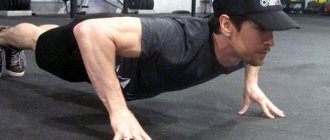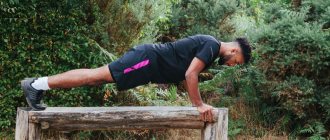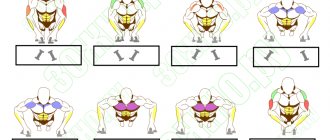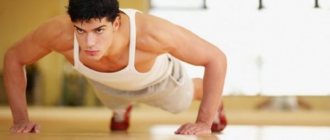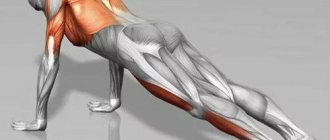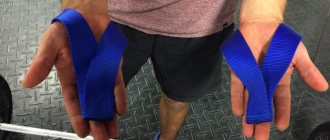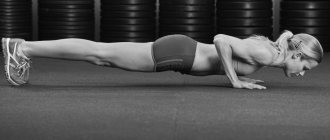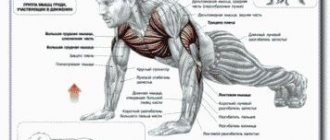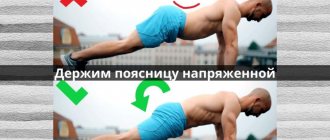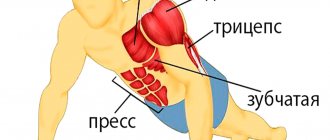Push-ups are an exercise thanks to which today you can significantly strengthen your physical condition and pump up many muscle groups. To perform this exercise, you do not need special equipment, you do not need to ask for the help of a sparring partner or look for a suitable place to train.
Push-ups are one of the most popular and one of the most effective exercises, the benefits of which are hard to deny.
Benefits of doing the exercise
The main advantage of push-ups is its practicality - you can do push-ups anywhere: at home, in the gym, in nature. Push-ups can increase endurance, strengthen muscles, and make the body stronger and healthier.
By doing push-ups regularly, you can achieve the desired result, namely:
- Pump up your abs.
- Strengthen your hands.
- Increase leg endurance.
People who regularly do push-ups reduce the risk of cardiovascular disease, heart attack, and stroke. Push-ups can be an ideal assistant in losing weight and creating a sculpted body.
Push-up sets can be used in many types of training, and proper alternation of exercises will help develop and strengthen exactly those muscles that are needed.
What can you achieve with push-ups?
If we approach the issue globally, then during push-ups almost all the muscles of our body work. However, when planning the training process, we can neglect the minor load that, say, the abs receive, and focus on those muscle groups that do the main work.
The most important factors involved in push-ups are:
- pectoral muscles (top, bottom or middle of the chest);
- triceps;
- deltoid muscles of the shoulders.
By changing the position of the arms and body, we can shift the emphasis of the load to any of the specified muscle groups. In addition to training muscles, push-ups are an excellent way to develop endurance, increase explosive strength (plyometric), train the cardiovascular system, strengthen ligaments and tendons.
In this article, we will first look at the classic exercise technique. Next, let's look at the following series of questions:
- What kind of push-ups should you use to train your pectoral muscles, arms and shoulders?
- How to strengthen your hands, fists and fingers?
- What types of plyometric push-ups are there (that develop explosive strength)?
- Complicated exercise options and work with additional weight for trained athletes.
- How to start a push-up training for beginners?
- How many repetitions and approaches should I do?
Most of the push-up options that will be listed below are covered in separate articles on our website. You can always read about the exercise in more detail by following the appropriate link.
How to do push-ups correctly?
Before starting a lesson, you must do the main warm-up: circular turns with your torso, shoulders, and arms.
Do not forget about the joints and hands, which should also be prepared for physical activity, especially when it comes to non-classical types of push-ups.
Today, there are many types of push-ups, based on which a certain technique is used.
In its classic form, the technique is as follows:
- Starting position: standing on the palms of your hands and toes. The conditional line from the heels of the feet to the back of the head should be smooth (the butt should not be raised up or lowered to the floor).
- Your toes should be together and your hands should be slightly wider than shoulder-width apart.
- On the count of “one,” bend your elbows and lower yourself down until your chest touches the floor.
- After this, we immediately rise up and get into the starting position.
- Further actions are performed identically. The back is straight, the butt does not rise up or fall down.
What muscles work when doing push-ups?
- Biceps and triceps (arm muscles).
- Back muscles.
- Abdominal muscles.
- Deltoid.
- Chest muscles.
- Gluteal muscles.
- Triceps and biceps brachii muscles.
- Neck muscles (partially, with the head raised up).
How to breathe correctly when doing push-ups?
For the exercise to bring maximum effect, you need not only to perform the technical component correctly, but also to master the breathing technique.
If breathing is incorrect, the following will occur:
- Shortness of breath.
- Circulatory disorders.
- Quick fatigue.
- The inability to achieve the desired result, since improper breathing will lead to a deterioration in well-being and a reluctance to exercise further.
To prevent improper breathing from causing problems, you need to remember only two things:
- Exhale on the way up.
- As you lower down, inhale, filling your lungs with oxygen.
Classical technique
The traditional version of the exercise looks like this:
- Take a lying position. Place your palms slightly wider than your shoulders and stretch your body into a string. The neck is an extension of the back, the stomach does not sag, the lower back is straight, the buttocks do not rise up. Place your feet at a short distance from each other on your toes.
- As you inhale, without changing the straight position of your body, lower your chest down by bending your arms at the elbow joints. There are a few centimeters left between the chest and the floor.
- As you exhale, straighten your arms and return to the top point.
This basic technique loads the pectoral muscles, triceps and slightly anterior deltoids. Additionally, the core stabilizer muscles work. It can be considered as a basis from which we will build when considering variations for accentuated training of specific muscles.
Push-up table
The push-up program for a person with average physical fitness looks like this:
| Day of the week | Approaches, number of times |
| Monday | First approach: 30 Second approach: 25 Third approach: 20 Fourth approach: 15 Fifth approach: 10 |
| Tuesday | First approach: 32 Second approachod: 27 Third approach: 22 Fourth approach: 16 Fifth approach: 10 |
| Wednesday | First approach: 33 Second approach: 28 Third approach: 23 Fourth approach: 16 Fifth approach: 10 |
| Thursday | First approach: 35 Second approach: 30 Third approach: 23 Fourth approach: 17 Fifth approach: 12 |
| Friday | First approach: 35 Second approach: 32 Third approach: 23 Fourth approach: 18 Fifth approach: 13 |
| Saturday | First approach: 37 Second approach: 32 Third approach: 25 Fourth approach: 18 Fifth approach: 13 |
| Sunday | First approach: 40 Second approach: 35 Third approach: 25 Fourth approach: 20 Fifth approach: 15 |
What can you achieve with push-ups?
Bending and extending the arms while lying down (the same push-ups) involves many muscles, both those directly involved in the work, and the stabilizer muscles responsible for balance and correct body position. For example, the abdominal muscles do not work dynamically, but tense when maintaining an even body.
As I said, thanks to the program described below, you can not only increase strength or endurance, but also achieve impressive size or incredible muscle detail.
Among the muscles worked during push-ups are:
- pectoral muscles (different sections with different positions of the palms);
- triceps or triceps muscles of the arms (also different sections, depending on the width and direction of the palms);
- anterior and middle deltoid muscles;
- latissimus dorsi muscles;
- trapezius muscles;
- small back muscles such as the teres major, rhomboid and other muscles.
I don’t take into account those who also strain during work. These are the abdominal muscles (rectus and external obliques), lumbar extensors, serratus muscles, biceps of the arms and muscles of the forearms. In short, you can see for yourself how wide the range of muscles involved is. I wrote more about the muscles involved in push-ups in this article.
Push-ups for beginners
For beginners, the main requirement is consistency. You shouldn’t try to do it a hundred times at once. Start with 10, 5 or even three repetitions and gradually increase the number of repetitions. It is also important to remember about the approaches: it is better to do three approaches 4-5 times than one approach 8-10 times.
| Day | Approaches, number of times |
| Monday | First approach: 7 Second approach: 5 Third approach: 3 |
| Tuesday | First approach: 7 Second approach: 6 Third approach: 3 |
| Wednesday | First approach: 8 Second approach: 7 Third approach: 4 |
| Thursday | First approach: 10 Second approach: 8 Third approach: 5 |
| Friday | First approach: 11 Second approach: 9 Third approach: 5 |
| Saturday | First approach: 13 Second approach: 10 Third approach: 6 |
| Sunday | First approach: 15 Second approach: 12 Third approach: 8 |
Simple options for beginners
In most cases, trained athletes, even without outside help, know what exercises to perform and how to ensure the load on certain muscle groups. But what should those who are just starting their journey do?
You can start by mastering push-ups from the “chest” and “triceps” points, just do them with emphasis on your knees and not on your feet. In this way, it will be much easier to hold your body and gradually your muscles will become strong enough to move on to the usual, and then to the more complicated technique.
Aim to increase the number of repetitions to 10-15 for at least three sets. Then increase the load, for example, by starting the first approach using the standard technique, and the next two from your knees.
General recommendations for beginners
- You should initially try to perform the exercise efficiently. Having learned to do it correctly, it will not be difficult for you to increase the quantity each time and become better. But if you neglect the technique at first, you can stumble upon the “effect of lack of results” and after a while give up the exercise.
- Watch your breathing. Breathing is the most important aspect of any exercise, particularly push-ups.
- Keep your back straight and don’t raise your butt high, making the task easier for yourself.
- Stick to regularity.
- Do other exercises to develop and improve your overall physical fitness (running, swimming, jumping, chest exercises, abdominal exercises, arm exercises, etc.).
- Before you start doing push-ups, be sure to warm up.
Complex exercise options
Listed below are exercises of a high degree of difficulty designed to demonstrate the athlete's good level of physical fitness. Namely, strength, muscle development, the ability to maintain balance and coordinate the work of the whole body.
Here are some of these exercises:
- Hindu push-ups.
- One-arm push-ups.
- Planche (a version of push-ups without legs or in the horizontal).
In addition to complicating the technique of bodyweight push-ups, you can increase the load by doing the exercise with additional weights. For example, you can ask your partner to place a barbell plate on your back. If you do push-ups at home, the load can be an ordinary backpack. A special weighted vest would also be a good purchase.
When doing push-ups with weights, you need to especially carefully monitor the technique of performing the movement.
Push ups
For men
The architecture of a man’s body is much stronger and more resilient than that of a woman, which is why a man needs to work on himself more and more intensively.
7 day workout:
| Day | Approaches, number of times |
| Monday | First approach: 25 Second approach: 20 Third approach: 18 Fourth approach: 15 Fifth approach: 10 |
| Tuesday | First approach: 27 Second approach: 20 Third approach: 20 Fourth approach: 17 Fifth approach: 12 |
| Wednesday | First approach: 29 Second approach: 22 Third approach: 20 Fourth approach: 17 Fifth approach: 12 |
| Thursday | First approach: 30 Second approach: 25 Third approach: 22 Fourth approach: 18 Fifth approach: 13 |
| Friday | First approach: 30 Second approach: 25 Third approach: 25 Fourth approach: 20 Fifth approach: 15 |
| Saturday | First approach: 33 Second approach: 28 Third approach: 25 Fourth approach: 20 Fifth approach: 15 |
| Sunday | First approach: 35 Second approach: 30 Third approach: 27 Fourth approach: 20 Fifth approach: 15 |
For women
Despite the opinion that push-ups are a man’s exercise, push-ups are no less beneficial for girls. And the execution may not be so difficult if you reduce the number of approaches and the number of times in each approach.
This table is designed for a woman with average physical fitness. If its implementation becomes difficult or impossible, you can do not 4, but three approaches and reduce the number of times.
Weekly training in the table:
| Day | Approaches, number of times |
| Monday | First approach: 10 Second approach: 8 Third approach: 5 Fourth approach: 3 |
| Tuesday | First approach: 12 Second approach: 10 Third approach: 5 Fourth approach: 4 |
| Wednesday | First approach: 13 Second approach: 10 Third approach: 6 Fourth approach: 5 |
| Thursday | First approach: 15 Second approach: 11 Third approach: 7 Fourth approach: 7 |
| Friday | First approach: 15 Second approach: 13 Third approach: 8 Fourth approach: 7 |
| Saturday | First approach: 17 Second approach: 15 Third approach: 10 Fourth approach: 8 |
| Sunday | First approach: 18 Second approach: 15 Third approach: 10 Fourth approach: 10 |
Training plans
We have selected effective push-up programs for beginners and advanced athletes.
Push-up program for girls from scratch
Above we presented a set of training exercises, by performing which you can strengthen the muscles of the arms and torso. If this complex is too complicated for you, we suggest dividing it into stages:
- Wall push-ups. Start with 2-3 repetitions. Add one push-up each day until you reach 15 per set.
- Platform push-ups. Similarly, start with 2-3 repetitions. Increase your sets by one push-up each day until you reach 15.
- Knee push-ups. The scheme is the same as for the previous two elements.
- Classic push-ups. Start with 2-3 reps and work your way up to 6-7 reps per set. After this, we recommend training according to the 30-day plan presented below.
Program for girls with an initial level of training (table for 30 days)
Exercises are performed 2 times a day: morning and evening.
| Day | Repetitions | Day | Repetitions | Day | Repetitions |
| 1 | 6 | 11 | 13 | 21 | 20 |
| 2 | 7 | 12 | 14 | 22 | 20 |
| 3 | 8 | 13 | 15 | 23 | 20 |
| 4 | 9 | 14 | 15 | 24 | Rest |
| 5 | 10 | 15 | 15 | 25 | 21 |
| 6 | 10 | 16 | rest | 26 | 22 |
| 7 | 10 | 17 | 16 | 27 | 23 |
| 8 | rest | 18 | 17 | 28 | 24 |
| 9 | 11 | 19 | 18 | 29 | 25 |
| 10 | 12 | 20 | 19 | 30 | 25 |
Push-up program for men with an initial level of training (table for 3 months)
Trainings are held 3 times a week. Pause between approaches - depending on how you feel.
| A week | 1 | 2 | 3 | 4 | 5 | 6 | 7 | 8 | 9 | 10 | 11 | 12 |
| Approach 1 | 6 | 7 | 8 | 9 | 10 | 11 | 12 | 13 | 14 | 15 | 16 | 17 |
| Approach 2 | 6 | 7 | 8 | 9 | 10 | 11 | 12 | 13 | 14 | 15 | 16 | 17 |
| Approach 3 | 4 | 5 | 6 | 7 | 8 | 9 | 10 | 11 | 12 | 13 | 14 | 15 |
| Approach 4 | 4 | 5 | 6 | 7 | 8 | 9 | 10 | 11 | 12 | 13 | 14 | 15 |
| Approach 5 | 5 | 6 | 7 | 8 | 9 | 10 | 11 | 12 | 13 | 14 | 15 | 16 |
| Total | 25 | 30 | 35 | 40 | 45 | 50 | 55 | 60 | 65 | 70 | 75 | 80 |
Push-up program for trained men (table for 11 weeks)
Number of training sessions: 3 per week. Rest - no more than 2-3 minutes.
| A week | 1 | 2 | 3 | 4 | 5 | 6 | 7 | 8 | 9 | 10 | 11 |
| Set 1 | 10 | 10 | 15 | 20 | 25 | 35 | 40 | 45 | 50 | 55 | 60 |
| Set 2 | 15 | 20 | 25 | 30 | 35 | 35 | 35 | 40 | 45 | 50 | 50 |
| Set 3 | 10 | 15 | 20 | 25 | 25 | 30 | 40 | 40 | 40 | 45 | 50 |
| Set 4 | 10 | 15 | 20 | 25 | 30 | 30 | 30 | 35 | 40 | 45 | 50 |
| Set 5 | 5 | 10 | 10 | 10 | 15 | 20 | 25 | 30 | 35 | 35 | 40 |
| Total | 50 | 70 | 90 | 110 | 130 | 150 | 170 | 190 | 210 | 230 | 250 |
Recommendations
- Between sets, take a 1 minute break, but if your physical condition is still weak, the break can be increased to 1 minute 30 seconds or even 2 minutes.
- Try to keep your body straight.
- Lower yourself down until your chest touches the surface, but do not lie on the floor (this makes the task easier and reduces the result of the exercise to zero).
- If doing push-ups on your toes is too difficult, you can start with push-ups on your knees.
- You can also do push-ups not from the floor, but from a bed or chair (this reduces the complexity of the exercise).
- On the contrary, for those who have already learned how to do push-ups well, you can complicate the task and place your feet on the bed, while your hands remain on the floor. This results in an angled push-up that increases the load.
Workout program for weight push-ups at home
Push-ups can give you about 75 percent of your weight on the pectoral muscles.
As we figured out, push-ups can achieve good results. Push-ups do not cover a large range of muscles. Shoulders, front deltoids and of course pectoral muscles. The effect depends on how you do push-ups and what goal you are pursuing. Everyone gets hung up on the number of reps. This is good if you want to progress in endurance. But the majority pursue the goal of increasing strength and increasing the volume of the chest, but unfortunately the number of push-ups does not affect this. How do you need to do push-ups effectively?
- Firstly, you need to do push-ups slowly, do everything smoothly. During fast push-ups, jerks occur during which our ligaments work more. They are the ones who bear the main burden. At the same time, the muscle does not work to its full potential.
- Secondly, you should feel your pectoral muscles.
- Thirdly, work in refusal. With proper push-ups, it becomes most effective for the growth of your muscles. That's when you will begin to progress.
Do I need to do push-ups every day? Don't forget the main thing in bodybuilding is the restoration of muscle groups. If you train the same muscle groups, they will not have time to recover. Therefore, more than one exercise cannot be done constantly without recovery. If your goal is endurance, then you can train every day, but even here you need to take break days. When working to gain weight, doing push-ups every day is useless.
Kinds
From the floor
Classic push-up, in which both legs and arms are on the floor.
Usually, a person stands on the palms of his hands and on his toes, but you can also do push-ups on your fists, fingers or hands.
The exercise from the floor on the palms of the hands trains mainly the biceps, triceps, pectoral and deltoid muscles. The press also pumps.
From the knees
A more simplified version of the classic push-up, created for training people with less developed physical abilities.
It is performed in the same way as the classic exercise, but the person stands not on his toes, but on his knees. The load in this exercise is small, but for an untrained person it is significant.
The arm muscles (biceps, triceps), pectoral muscles and deltoids are also trained. The load on the press is much lower.
From the wall
Wall push-ups are one of the most difficult types of push-ups. Here, a huge load is placed on the arms and shoulder girdle, and in order to perform this exercise, you need to have serious physical fitness.
In order to complete the exercise, you need:
- Stand with your back to the wall, then lower your hands to the floor and take your starting position - on all fours.
- Climb the wall with your feet as high as possible, and pull your hands (in small steps) closer to the wall.
- Slowly bend your arms and lower yourself down until your head touches the surface.
- Then immediately straighten your arms and return to the starting position.
Wide grip
An exercise that is aimed at developing the pectoral muscles. In addition to the chest, the exercise also works well on the arms.
Done this way:
- We get into the starting position, as in a classic push-up (palms on the floor, feet on toes together).
- Then we spread our arms as wide as possible, while keeping our toes together.
- We do push-ups.
- When we go down, we inhale, when we go up, we exhale.
- You can complicate the task by adding additional supports for your arms and legs; in this case, you can go much lower, thanks to which additional muscle groups will be involved.
With a medium grip
Trains the arm muscles, abdominal muscles and shoulder girdle muscles. Also, the back muscles receive a huge load from static tension.
Push-ups are performed with a medium grip as follows:
- Starting position: standing on the palms of your hands and toes.
- The distance between the palms is slightly more than shoulder width.
- As you inhale, lower yourself down, touching the surface with your chest.
- As you exhale, rise up to the starting position.
- It is important that the head does not drop down too much and does not lift up.
With a narrow grip
Close-grip push-ups are performed to work the deltoids, triceps and pectoral muscles. Push-ups with a narrow grip are much more difficult than the classic type, which is why they are performed by people with good physical fitness.
Technique:
- Starting position: standing on your toes and palms of your hands.
- Place your palms together and place your toes shoulder-width apart.
- As you inhale, bend your elbows and lower yourself down, and as you exhale, rise up.
- In push-ups with a narrow grip, there are two options for raising the elbows: to the sides and along the body.
- If you move it to the sides, the load goes more on the chest and shoulder girdle.
- If the arms go along the body, then the load mainly goes on the shoulders and arms.
On one hand
Push-ups on one arm are needed in order to increase the load on certain muscle groups: deltoids, triceps, biceps, pectoral and others.
Mostly, people who are already able to perform several dozen classic push-ups and require additional load to develop their physical condition begin to do push-ups on one arm.
- Get into the starting position as in a classic push-up.
- Then spread your toes slightly and throw one arm behind your back.
- Bend your elbow and lower yourself down.
- Using maximum effort, push yourself out and try to rise up, taking the starting position.
- Do it several times and change the loaded hand.
With clap
The clapping exercise is performed to develop speed and strength qualities. The pectoral muscles, arm muscles and abdominal muscles are involved. Clapping push-ups are used in the training process of many athletes, so it is difficult to overestimate its importance and effectiveness.
In addition, the clapping exercise can be performed by both a professional athlete and a beginner. The only difference is the quality of execution, the number of times and the presence of complications.
Technique:
- We take a comfortable starting position.
- Toes and hands shoulder-width apart.
- Having dropped down a little, we sharply push ourselves up and at this time make a clap at chest level.
- We get into the starting position (the main thing is not to fall).
- We repeat the exercise several approaches 5-10 times.
In addition to regular clapping, you can also clap behind your back. This exercise is much more difficult than the previous one, but the result from its implementation will be significant.
Important! Before you try to do a clap behind your back, learn how to do a good push-up with a clap at chest level, since push-ups with a clap behind your back require serious reaction and speed, and if you do not have this, you can simply fall on your nose to the floor and get injured.
On fingers
Push-ups on the fingers are a little different from other types of push-ups, since the load here goes to the wrist area and develops the strength of the fingers. There are also different types of finger push-ups: push-ups on all fingers, push-ups on one finger, push-ups on three fingers and others.
Performance:
- Take the starting position, as in a classic push-up.
- Then, from the palm stand, stand on your fingers (it is very important to learn how to hold yourself in this position so that your fingers do not move apart).
- Perform push-ups, 3 sets of 3-5 times.
In the future, when your fingers get stronger and your arm muscles become stronger, you will be able to do dozens of push-ups without pain or much effort.
With weights
When doing push-ups with weights, the main emphasis is on the load on the muscles.
By “weights” we mean dumbbells, various special equipment, as well as a partner, who can be placed on the back or asked to apply a little pressure from above to increase the load when extending the arms and lifting.
The latter method is very effective, since the load can be doubled or more.
For this:
- Take the starting position: stand on the palms of your hands and toes.
- Start doing standard push-ups (to warm up).
- Then ask your partner to apply a little pressure with his hands on his back and increase the pressure each time.
- If this is not enough, ask your partner to sit on your back, but it is important that the weight of your partner does not cause you pain.
- Perform push-ups until you realize that your strength is running out.
- After the push-ups, do some light stretching to tone your muscles.
If the method with a partner is not suitable, you can put a barbell plate on your back (select the weight individually, it should be noticeable, but not too heavy).
And if push-ups are performed at home, and you don’t have a barbell plate at hand, you can use improvised means, such as:
- Packets of cereal.
- A bag of flour or sugar.
- A bag filled with things and other things.
Push-up home training program for beginners
The first level is 6 approaches of 15 times using the correct technique for performing classic push-ups. The next level for you will be push-ups with legs on a hill. The system remains the same. In future workouts you need to add hand rests. (we drop to the maximum) Next, add additional weights (+5 kg + 10 kg + 15 kg) Train every other day, change the weights and types of push-ups, the most important thing is to recover correctly and see powerful progress.
Don't forget that you can't do push-ups every day - it's harmful! Muscle acidification and overtraining occur. I myself have personally used this technique and have repeatedly advised it not only to professional, but also to beginning athletes...
No training equipment or additional weights are required, all you need is your desire and motivation. The push-up home workout program can be done both at home and outdoors. The training time should take no more than 30 minutes. Approaches and quantity depend on your preparedness! The main thing is the result of the training - the correct execution of push-ups.
An important principle of training is its construction.
On the first day, be sure to record the number of repetitions, the number of approaches and the time it took you to complete it. Every day, increase the number and decrease the approaches accordingly. Do not forget about the time frame of 25 - 30 minutes no more! Don't focus on the basic exercise, do push-ups with a wide, narrow grip! Work different muscle groups. Use chairs at home. Don't forget that there is an upper and lower chest - change the angle of inclination when doing push-ups!
After five or six days of training, move on to weighted push-ups! Use available tools. The most basic thing is a backpack bag with water bottles! Start depending on your recovery and fitness level! Increase your sets of weights every workout. You will definitely see progress!
Yes, your muscles will ache and they will get tired, but you must go to the goal because at the end of the road another victory awaits us. Recovery, proper nutrition, healthy sleep - all this contributes to a positive result! I am sure in 14 days when you overcome pain, fatigue, the desire to give up halfway, you will receive enormous satisfaction! Don't forget that sport for us is our life. We have connected our lives with sports and now every morning we wake up as winners!!!!
This is a push-up home training program, after which I undoubtedly progress not only in gaining muscle mass, but it also helps improve my physical performance, I use it once every six months. This helps you take your mind off your main training and improve your performance on one of the most important compound exercises... You'll experience positive results in the process. Get the most out of your workouts!!
Crossfit complexes with push-ups
- Classic push-ups – 10 times.
- Back push-ups (triceps) – 10 times.
- Wide grip push-ups – 8 times.
- Push-ups with cotton – 8 times.
- Close-grip push-ups – 5 times.
- Push-ups on your knees – 15 times.
Each exercise is performed with a break of no more than 20 seconds, preferably without a break. This set of exercises is aimed at developing speed-strength qualities, endurance, as well as the strength of the pectoral muscles, triceps, biceps, deltoids and abs.
You need to perform it in the same sequence as indicated in the complex, but increase it by 2-3 times every day so that the load on the muscles increases. Push-ups can be included in a complex of general physical training and then push-ups should be performed with a break of 1-1.5 minutes.
Push-up home training program (mistakes)
I will tell you about the mistakes that prevent the growth of the pectoral muscles.
Everyone knows that push-ups are one of the most basic exercises; progress can be endless. The first mistake is the amplitude of movement
. Steadily, you should go as low as possible (touch your chest to the floor) and tense your pecs as you rise. Feel your pectoral muscle group.
The second mistake is your pace.
If you are training for endurance, then push-ups should be done at a fast pace, but if you are working on building chest shape, such push-ups are not permissible. The approximate tempo when working is 6 seconds down and 3 seconds up. When you change the pace and amplitude of the movement, you will immediately feel how your pectoral muscles are worked.
Third error: no progress.
Make your push-ups harder.
Raise your level. Along the way, we’ll look at the training program.
Push-ups for gaining muscle mass
To gain muscle mass, you need to regularly perform certain types of push-ups:
- Push-ups on stands (at home these can be books or dumbbells). It is performed like a regular push-up, but due to the height of the stands you can go lower, so the muscles are worked better.
- Push-ups with wide arms. Thanks to the wide stance, the load on the muscles increases, and with it, the desired result (pump up) comes faster.
- Push-ups while standing with your feet on a stool or bed . Push-ups occur at an angle, the load increases, and the upper chest muscles are well worked.
Dips at home training program
In my opinion, the main basic exercise for the chest is, of course, the bench press, and the second most important exercise is the parallel bars. If you want big breasts, you should definitely do dips. The at-home dips training program is effective not only in the gym, but also if you train on the sports field. If you want to become big, be sure to increase the weight of the weight. Without parallel bars, it is not possible to fully progress in increasing the pectoral muscles.
Dips at home training program for beginners
Set of 9 approaches. The main thing is to work not only with your own weight, but also be sure to use weights like backpacks, chains, and weights.
- approach (warm-up) 8-16 repetitions with your own weight.
- set 6-15 with maximum weights
- set 6-15 with maximum weights
- set 6-15 with maximum weights
- approach 6-15 average weight
- approach 6-15 average weight
- approach 6-15 average weight
- maximum bodyweight approach
- bodyweight approach to the max.
The break between sets is 2 minutes. By technique. Lean forward a little, look at the floor, elbows to the side so that your chest works well. Body back. Get down as low as possible and stretch your chest. At the top we take a short pause to contract the chest muscles. Raise your knees slightly. Don't skip the negative phase, do everything slowly. Don't swing.
Push-ups with emphasis on triceps
There are 2 effective types of push-ups that will help you quickly pump up your triceps:
- Narrow grip push-ups. Get into the starting position: toes together, palms of your hands next to each other. Inhaling, lower yourself down, spreading your elbows to the sides or along the body, exhaling, rise up and take your starting position.
- Reverse push-up. Approach your back to the bed or high chair, place your palms on the edges and lower your pelvis down, bending your arms. The legs should be straightened forward. After this, straighten your arms and lift your pelvis up. It is important that the body moves along a conventional vertical line parallel to the bed (chair).
Strengthening your fists, hands and fingers
So, above we looked at three main groups of push-ups, differing in the width of the arms and the position of the body relative to the floor. But the scope of the exercise is not limited to training the chest, triceps and shoulders.
Now let's move on to narrower points, for example, targeted strengthening of the hands and fingers. This aspect is extremely important when practicing martial arts and any sports that involve striking with fists, palms or fingers.
To strengthen the striking surface of the fist and the ligaments of the hands, push-ups are used on the fists and on the back of the hands. Doing push-ups on your fingers will help make your fingers strong and strong.
100 push-ups program
This program will help you reach your desired goal of 100 push-ups. In addition to following the program, you need to eat right and engage in additional physical activity (running, stretching, team sports).
Be sure to warm up and stretch before each workout. Particular attention is paid to the shoulder girdle and joints. Don't quit what you started halfway.
If you feel that you don’t have the strength to train further, reduce the number of push-ups to the norm that will be comfortable for you and continue to increase it.
So, an approximate workout for a month:
| Day | Approaches, number of times |
| Monday | First approach: 20 Second approach: 17 Third approach: 15 Fourth approach: 13 Fifth approach: 10 |
| Tuesday | First approach: 22 Second approach: 18 Third approach: 15 Fourth approach: 13 Fifth approach: 11 |
| Wednesday | First approach: 24 Second approach: 18 Third approach: 17 Fourth approach: 14 Fifth approach: 11 |
| Thursday | First approach: 25 Second approach: 20 Third approach: 17 Fourth approach: 15 Fifth approach: 12 |
| Friday | First approach: 28 Second approach: 23 Third approach: 18 Fourth approach: 16 Fifth approach: 12 |
| Saturday | First approach: 30 Second approach: 25 Third approach: 19 Fourth approach: 17 Fifth approach: 14 |
| Sunday | First approach: 33 Second approach: 27 Third approach: 20 Fourth approach: 18 Fifth approach: 15 |
| Monday | First approach: 35 Second approach: 30 Third approach: 22 Fourth approach: 18 Fifth approach: 15 |
| Tuesday | First approach: 38 Second approach: 33 Third approach: 24 Fourth approach: 19 Fifth approach: 16 |
| Wednesday | First approach: 40 Second approach: 35 Third approach: 27 Fourth approach: 21 Fifth approach: 17 |
| Thursday | First approach: 43 Second approach: 38 Third approach: 30 Fourth approach: 23 Fifth approach: 18 |
| Friday | First approach: 45 Second approach: 40 Third approach: 32 Fourth approach: 25 Fifth approach: 18 |
| Saturday | First approach: 47 Second approach: 42 Third approach: 34 Fourth approach: 26 Fifth approach: 20 |
| Sunday | First approach: 49 Second approach: 45 Third approach: 37 Fourth approach: 28 Fifth approach: 21 |
| Monday | First approach: 51 Second approach: 48 Third approach: 40 Fourth approach: 29 Fifth approach: 21 |
| Tuesday | First approach: 53 Second approach: 50 Third approach: 43 Fourth approach: 33 Fifth approach: 23 |
| Wednesday | First approach: 55 Second approach: 50 Third approach: 44 Fourth approach: 34 Fifth approach: 24 |
| Thursday | First approach: 57 Second approach: 52 Third approach: 46 Fourth approach: 36 Fifth approach: 25 |
| Friday | First approach: 59 Second approach: 53 Third approach: 49 Fourth approach: 39 Fifth approach: 26 |
| Saturday | First approach: 62 Second approach: 55 Third approach: 49 Fourth approach: 43 Fifth approach: 28 |
| Sunday | First approach: 64 Second approach: 59 Third approach: 52 Fourth approach: 45 Fifth approach: 30 |
| Monday | First approach: 67 Second approach: 61 Third approach: 55 Fourth approach: 49 Fifth approach: 33 |
| Tuesday | First approach: 70 Second approach: 65 Third approach: 57 Fourth approach: 53 Fifth approach: 35 |
| Wednesday | First approach: 74 Second approach: 69 Third approach: 60 Fourth approach: 56 Fifth approach: 35 |
| Thursday | First approach: 78 Second approach: 72 Third approach: 63 Fourth approach: 59 Fifth approach: 37 |
| Friday | First approach: 82 Second approach: 77 Third approach: 67 Fourth approach: 62 Fifth approach: 39 |
| Saturday | First approach: 87 Second approach: 80 Third approach: 70 Fourth approach: 65 Fifth approach: 41 |
| Sunday | First approach: 90 Second approach: 85 Third approach: 74 Fourth approach: 69 Fifth approach: 43 |
| Monday | First approach: 94 Second approach: 88 Third approach: 78 Fourth approach: 72 Fifth approach: 45 |
| Tuesday | First approach: 98 Second approach: 93 Third approach: 80 Fourth approach: 74 Fifth approach: 48 |
| Wednesday | First approach: 100 Second approach: 93 Third approach: 84 Fourth approach: 76 Fifth approach: 50 |
We make stops with our own hands
You can purchase equipment at any large sports store. Prices for stationary models start from 500 rubles, rotating stops are more expensive - from 2000 rubles. If you don't want to spend money, make the accessories yourself and train for your own pleasure.
- The easiest way is to stack several books in two identical piles. This option will allow you to increase or decrease the height of the stands at any time. Instead of books, you can use boards or bricks.
- The second method is a little more complicated. We purchase two plaster trowels (wooden or polyurethane). We cut out several identical pieces of board under the base and fasten them with self-tapping screws to the graters.
Recommendation: if the improvised stops do not have a rubber base, place a mat under them when performing. This will help you avoid falling on a slippery floor.
Pull-ups and push-ups
Both pull-ups and push-ups are very effective exercises; they can only be beneficial if they are performed together.
The only thing is, by training both push-ups and pull-ups at the same time, you will exercise more intensely. As a result, you will begin to have difficulty performing individual cycles in each workout.
But it’s worth a try, because push-ups develop the chest muscles, and pull-ups develop the shoulders. This way your muscles and strength will grow together and faster. It is advisable to carry out training alternately: one day - push-ups, the other day - pull-ups.
How to do push-ups. Initial position.
Before starting push-ups, take a horizontal position on your hands. Place your feet together, hands resting on the floor at a distance of approximately 70-90 cm from each other. Fingers point forward. The body and legs should be in one line. The head position should be neutral. It should not hang down, but it should not be raised high either. The gaze should be directed to a point on the floor located about half a meter from the hands.
Please note that the body and legs should be approximately in line. This is an important condition for high effectiveness of push-ups.
https://www.youtube.com/watch?v=0o-a6Z3M4tY
World records in push-ups
While we do 50 times and dream of reaching 100, record holders calmly perform hundreds and even thousands of times, getting into various record books.
Main records:
- the greatest number of push-ups without a break - ten and a half thousand times.
- Of the women, the American Maria Tobar did the most push-ups (without a break) - 302 times.
- The world record for push-ups for the year is 1 million 500 thousand 230 times.
- In 24 hours, a person was able to do 46 thousand push-ups.
- In one hour, the men's record is 3 thousand 877 times, and the women's record is 1 thousand 20 times.
- Women's record in 30 minutes - 829 times, in 10 minutes - 450 times, and in 3 minutes - 190 times.
- The record for one-arm push-ups in 1 hour is 2521 times, in 30 minutes – 1382, and in 10 minutes – 546.
- In push-ups with fists, the record is 5557 times.
- A man was able to do 124 push-ups on one finger
- And on one hand in a handstand - 12 times.
- The record for 1000 timed push-ups belongs to Doug Pruden and is 18 minutes and 13 seconds.
- The record for push-ups on the back of the hands in one hour is 1940 times, in half an hour – 1386 times, and in 15 minutes – 627 times.
- The record for push-ups on raw eggs is 112 times.
- And the greatest number of times in one minute for a person without legs is 36 times.
Alexandrova Anastasia
Nutrition and healthy lifestyle specialist and author of myfitnesblog.com. For many years, she has successfully helped women and men lose weight and maintain a beautiful figure.
Second week of training
At the end of the second week, 1-2 days after the last workout, you must take the endurance test again, performing the maximum number of push-ups. Write down this result, it will be useful to you when planning your third week of training.
Table. Second week of training
Do women gain muscle at the same rate as men?
1upnutrition.com
Men and women “build” muscles differently. Testosterone plays a big role in their development, and although men have more of it, it is present in the body of both sexes - so both men and women respond almost equally to strength training.
Muscle growth is also affected by:
- body size;
- constitution;
- age;
- health status;
- hormone levels.
In general, changes in muscle mass tend to occur in people of all genders, but are more noticeable in those who have more to begin with. Set realistic expectations. If the Incredible Hulk doesn't look at you in the mirror after a month of training, don't get upset and don't quit. Increasing natural muscle mass requires patience and persistence.
see also
Arnold Schwarzenegger posted a home workout plan online
Types of stops - how to choose
- Horizontal - straight stops in the form of handles; some companies make collapsible stops with varying height levels.
- Inclined - made with inclined handles, they can also be collapsible or stationary.
- Rotary – supports for push-ups, with the ability to rotate the hand while performing the exercise.
- Curved - a type of horizontal stationary stops in the form of a “snake”.
What to look for when choosing stops
- Racks must be made of high-strength plastic or metal.
- Rubberized stands should not slide on the floor surface.
- The material of the holders should be made of a durable but soft shell - neoprene, which increases grip comfort and maintains its integrity for a long time.
Manufacturers of stops
- Indigo is a Chinese manufacturer of stops made of durable steel and plastic that can withstand weights of up to 120 kg, with neoprene handles. Price about 505 rub.
- Push Up Pro – high strength swivel stops, can withstand loads up to 130 kg. Approximate price - 550 rubles.
- Power System - the brand offers multi-level collapsible stops, costing from 390 rubles.
- Torneo - they produce straight and curved stops with a soft neoprene coating. Withstands loads up to 100 kg. Cost from 799 rub.
- Kettler – stops include: steel, plastic, neoprene. The cost of goods from 1999 rubles.
